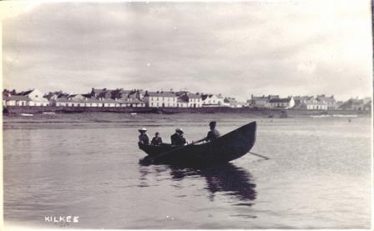Kilkee Currachs

Currachs, canoes(pronounced: CANoes), and their part in the heritage of Kilkee
Kilkee has always faced the sea so it is inevitable that the Atlantic Ocean and fishing has played a major role in the heritage and history of the town. The first written description of the boats used by fishermen in West Clare came in Lloyd’s Tour of Clare in 1780[1].
“There is an Artificial Curiosity made use of by certain Individuals. It is a canoe or Currach, composed of Wattles, covered with Raw Hide: With this Indian-like construction, they Fish successfully in the proper season and Paddle some Leagues out in calm weather.”
Later, 1808, Dutton in his survey of County Clare, he too commented on the currachs on the coast of Clare and he said at that time they were covered in horse or cow hides.This is where the name ‘skin’ boats comes from and it is still called this name in certain places..
By 1822 Captain Frazer of the Royal Navy in an article published in the Clare Journal expressed surprise that men could be found to venture out into the Atlantic Ocean in so ‘frail a bark’. He noted that the frame was covered in canvass. This canvass was made from linen because of the large quantity of flax grown in the area. In 1836 a Commission of Enquiry into Irish Fisheries was established and it made a number of recommendations. To persuade fishermen to upgrade to the new canvass type of canoe, loans were made available to purchase them. At the same time piers and quays were built along the Clare coast (Doonbeg, Liscannor, Quilty) for landing catches but Kilkee did not benefit at that time. Local canvass was eventually replaced by cheap imported hessian and jute.
Two Months at Kilkee.
In 1835 Mary John Knott, in her wonderful book, Two months at Kilkee, gives a vivid description of life in Kilkee at that period. About the canoes she says:
“The natives use canoes for fishing, which are the only description of boat to be found along this coast. About twenty of these comprise the fishing establishment at Kilkee: they are composed of a frame of light timber or strong wicker work, covered with sail-cloth rendered waterproof with pitch and tar. The best kinds have slight timber hoops to support the cloth. which is an improvement. A few years since they were covered with horse and cow hides, after the custom of the ancient Irish: these little vessels have neither keel nor rudder; they are particularly calculated to skim over the surface of the waves, and pass safely amongst the rocks on this dangerous shore, where a timber boat might be dashed to pieces.”
While Mary John Knott was impressed on how safely the canoes could navigate the rocks on the dangerous shore , the reality is that there were numerous drownings and local newspapers of the time carried regular reposrts of men lost at sea. There is a prominent point on the present promenade which is called Fishemen’s Corner. From this position one has a vantage point to observe the entrance to Kilkee Bay. it was here, in bad weather, that the womenfolk of the fishermen watched and waited for the returning boats. If they were very late prayers were recited and other canoes went out to search for their comrades. If one was seen returning towing an upturned canoe the wails and keening could be heard all over the town. Many fishermen had a small plot of land which helped supplemet their fishing income. Those that were full time fishermen took geater risks with inclement weather and sometimes paid the price.
When fishing was quiet the men turned to tourism and took visitors out for ‘spins’ around the bay. The more adventurous of these visitors hired a trip around the spectacular cliffs which run north and south from the town. They also visited some of the caves for even more excitement.
Canoes Revitalised
These were the currachs which with minor adaptations were used in Kilkee until towards the end of the 20th century. With the demise of the currach and with the half deck timber boats with outboard engines taking over the fishing as well as the days of the great herring and mackeral catches being over, the reduced numbers depending on fishing for a livlihood turned to lifting lobster pots with a bit of longlining if the fish were ‘in’. This appeared to be the end of the currach but traditions die hard and the fishing communities in Kerry, Clare and Galway took to competeing against each other in racing regattas. Now the curragh design changed again and for racing what was needed was very light boats for speed. The regattas were always run in fine weather so the heavier seaworthy boats were not required. Another change occured because of the lighter design. Women who seldom figured in traditional currachs now took part in the racing. Now any self-respecting regatta organisers make sure there are women only and mixed crews on every card.
Kilkee Currach Club
While the racing currach was the kingpin in the bays of west Munster some people pined for the older traditional currach. Kilkee Currach Club decided to build their own traditional boat using the design of Cully Marrinan one of Kilkee legendery boatbuilders from the end of the 19th century and some of whose canoes still survive.He built 123 new boats and repaired hundreds of others during his 95 year lifetime. Having built one, the Kilkee club decided to build more so it ended up building six altogether and gave away five of them to other traditional currach communities. Now regattas always have one race dedicated to the older heavier and traditional canoes. Tradition lives on.
[1] John Lloyd – A Short Tour in the County Clare 1780.




No Comments
Add a comment about this page